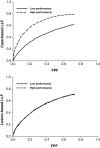Clinical relevance of the ROC and free-response paradigms for comparing imaging system efficacies
- PMID: 20139268
- PMCID: PMC2868120
- DOI: 10.1093/rpd/ncq017
Clinical relevance of the ROC and free-response paradigms for comparing imaging system efficacies
Abstract
Observer performance studies are widely used to assess medical imaging systems. Unlike technical/engineering measurements observer performance include the entire imaging chain and the radiologist. However, the widely used receiver operating characteristic (ROC) method ignores lesion localisation information. The free-response ROC (FROC) method uses the location information to appropriately reward or penalise correct or incorrect localisations, respectively. This paper describes a method for improving the clinical relevance of FROC studies. The method consists of assigning appropriate risk values to the different lesions that may be present on a single image. A high-risk lesion is one that is critical to detect and act upon, and is assigned a higher risk value than a low-risk lesion, one that is relatively innocuous. Instead of simply counting the number of lesions that are detected, as is done in conventional FROC analysis, a risk-weighted count is used. This has the advantage of rewarding detections of high-risk lesions commensurately more than detections of lower risk lesions. Simulations were used to demonstrate that the new method, termed case-based analysis, results in a higher figure of merit for an expert who detects more high-risk lesions than a naive observer who detects more low-risk lesions, even though both detect the same total number of lesions. Conventional free-response analysis is unable to distinguish between the two types of observers. This paper also comments on the issue of clinical relevance of ROC analysis vs. FROC for tasks that involve lesion localisation.
Figures

Similar articles
-
Consistency of methods for analysing location-specific data.Radiat Prot Dosimetry. 2010 Apr-May;139(1-3):52-6. doi: 10.1093/rpd/ncq030. Epub 2010 Feb 16. Radiat Prot Dosimetry. 2010. PMID: 20159917 Free PMC article.
-
A status report on free-response analysis.Radiat Prot Dosimetry. 2010 Apr-May;139(1-3):20-5. doi: 10.1093/rpd/ncp305. Epub 2010 Jan 18. Radiat Prot Dosimetry. 2010. PMID: 20085898 Free PMC article.
-
Quantifying the clinical relevance of a laboratory observer performance paradigm.Br J Radiol. 2012 Sep;85(1017):1287-302. doi: 10.1259/bjr/45866310. Epub 2012 May 9. Br J Radiol. 2012. PMID: 22573296 Free PMC article.
-
ROC, LROC, FROC, AFROC: an alphabet soup.J Am Coll Radiol. 2009 Sep;6(9):652-5. doi: 10.1016/j.jacr.2009.06.001. J Am Coll Radiol. 2009. PMID: 19720362 Review. No abstract available.
-
Analysis of location specific observer performance data: validated extensions of the jackknife free-response (JAFROC) method.Acad Radiol. 2006 Oct;13(10):1187-93. doi: 10.1016/j.acra.2006.06.016. Acad Radiol. 2006. PMID: 16979067 Review.
Cited by
-
EXTRACOLONIC FINDINGS-IDENTIFICATION AT LOW-DOSE CTC.Radiat Prot Dosimetry. 2021 Oct 12;195(3-4):188-197. doi: 10.1093/rpd/ncab054. Radiat Prot Dosimetry. 2021. PMID: 33855447 Free PMC article.
-
Mammographic detection of breast cancer in a non-screening country.Br J Radiol. 2018 Nov;91(1091):20180071. doi: 10.1259/bjr.20180071. Epub 2018 Jul 26. Br J Radiol. 2018. PMID: 29987982 Free PMC article.
-
Radiologist Self-training: a Study of Cancer Detection when Reading Mammograms at Work Clinics or Workshops.J Cancer Educ. 2023 Apr;38(2):571-577. doi: 10.1007/s13187-022-02156-w. Epub 2022 May 5. J Cancer Educ. 2023. PMID: 35511333 Free PMC article.
-
Improving radiologist's ability in identifying particular abnormal lesions on mammograms through training test set with immediate feedback.Sci Rep. 2021 May 10;11(1):9899. doi: 10.1038/s41598-021-89214-3. Sci Rep. 2021. PMID: 33972611 Free PMC article.
-
ROC or FROC? It depends on the research question.Med Phys. 2017 May;44(5):1603-1606. doi: 10.1002/mp.12151. Epub 2017 Mar 17. Med Phys. 2017. PMID: 28168710 Free PMC article. No abstract available.
References
-
- Metz C. E. ROC Methodology in radiologic imaging. Invest. Radiol. 1986;21(9):720–733. - PubMed
-
- Metz C. E. Some practical issues of experimental design and data analysis in radiological ROC studies. Invest. Radiol. 1989;24:234–245. - PubMed
-
- Metz C. E. Receiver operating characteristic analysis: a tool for the quantitative evaluation of observer performance and imaging systems. J. Am. Coll. Radiol. 2006;3:413–422. - PubMed
-
- Chakraborty D. P., Berbaum K.S. Observer studies involving detection and localization: modeling, analysis and validation. Med. Phys. 2004;31(8):2313–2330. - PubMed
-
- Penedo M., et al. Free-response receiver operating characteristic evaluation of Lossy JPEG2000 and object-based set partitioning in hierarchical trees compression of digitized mammograms. Radiology. 2005;237(2):450–457. - PubMed
Publication types
MeSH terms
Grants and funding
LinkOut - more resources
Full Text Sources

